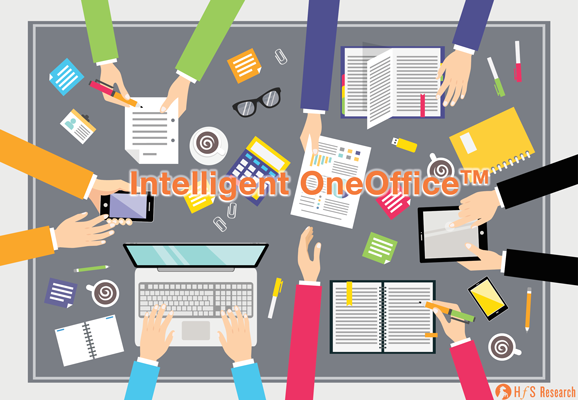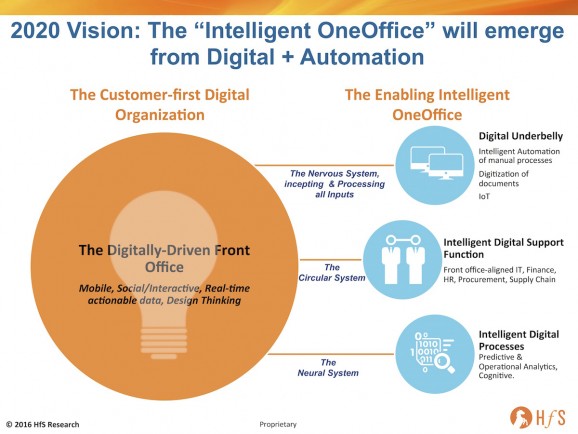 If someone called you “back office”, I’d imagine you’d be a little bit offended. It’s probably not much worse than being called “useless”, or “about to be automated out of existence”…
If someone called you “back office”, I’d imagine you’d be a little bit offended. It’s probably not much worse than being called “useless”, or “about to be automated out of existence”…
But I have good news for you back-office rebels – your time spent festering in the backend of yonder is finally coming to an end. Why? Because the onset of digital and emerging automation solutions, coupled with the dire need to access meaningful data in real-time, is forcing the back and middle to support the customer experience needs of the front.
Our soon-to-be-released study on achieving Intelligent Operations, which canvassed 371 major buy-side enterprises, reveals two key dynamics that are unifying the front, middle and back offices:
- A “customer first mindset” is the leading business driver driving operations strategies. Over half of upper management (51%) view their customers’ experiences as impacting sourcing model change and strategy, which is placing the relevance and value of the back office in the spotlight.
- Three-quarters of enterprises (75%) claim digital is having a radical impact. We can debate the meaning and relevance of digital forever, but the bottom line is that enterprise leaders need to (be seen) to have a digital strategy – and a support function that can facilitate these digital interactions and data needs. The old barriers where staff in the back office don’t need to think and merely oversee operational process delivery, and those in the middle, which only venture a part of the way to aligning processes to customer needs, are fading away.
Consequently, we’re evolving to an era where there is only “OneOffice” that matters anymore, creating the digital customer experience and an intelligent, single office to enable and support it:
Introducing the Intelligent OneOffice, where the barriers between front, middle and back are forever going away
The Digitally-driven Front Office drives everything. Digital, in its purest form, is all about transforming the business to create, support, and sustain the digital customer experience. It’s about leveraging the omnichannel (mobile, social, interactive tech, etc) and accessing meaningful analytics to make it happen. But then you need a support function to service those customers, get their products/services to market when they want them, manage the financial metrics, understand their needs and future demands, and make sure you’ve got the talent that truly understands the outcomes of their work.
The Digital Underbelly creates the building blocks. Digitally-driven enterprises must create a Digital Underbelly to support the front office by automating manual processes, digitizing manual documents, and leveraging smart devices and IoT where they are present in the value chain. You just can’t do digital without automating smartly – forget all the hype around robotics and jobs going away; this is about making processes run digitally so we can grow our businesses and create new jobs. Think about a central nervous system that incepts and processes all the elements necessary to make the enterprise function.
Intelligent Digital Support breaks down the legacy functional silos. You need your support functions (like an enterprise circular system), such as IT, finance, HR, and supply chain, to be aligned with supporting the customer experience, as opposed to operating in some sort of vacuum. Hence, we are terming this “Intelligent Digital Support,” where broader roles can be created. Today’s college graduates are simply not coming out of school willing to perform mundane routine work: operations staff proactively need to support the fast-shifting needs of the front office. So the focus needs to shift towards creating a work culture where individuals are encouraged to spend more time interpreting data, understanding the needs of the front end of the business, and ensuring the support functions keep pace with the front office. This is especially the case in industries that are more dependent than ever on real-time data, using multiple channels to reach their customers and being able to think out-of-the-box with disruptive business models. Of course, we all need to make sure we can keep the operations functioning by paying the bills, responding to customers, processing the claims etc, but if we can’t be proactive and look at how we can create a better customer experience using digital channels, or challenging the logic of running a process a certain way, we’ll never create work cultures that will attract the bright minds to take us forward. People want to feel a part of something and that their work matters – and the best way to do this is to move away from rigid corporate structures of the past, with too many management layers and departments run siloed like mini-empires. We need to invest in driven managers which understand how to motivate and collaborate across business functions. Sales, marketing, customer service, IT, finance, HR and supply chain are functions that all depend on each other to be effective. Smart enterprises are already breaking down the silos and creating multidisciplinary teams, using collaborative tools and Design Thinking methods across delivery centers to help their staff be more motivated, creative and challenging the old way of doing things.
Intelligent Digital Processes can help us predict as opposed to react. And finally… it’s all about designing business processes that align with your desired digital customer experience. It’s not about throwing off historical data just to discover what went wrong… it’s about being able to predict when things will go wrong and finding clever ways to get ahead of them. It’s about embedding smart cognitive applications into process chains, about learning from mistakes and new experiences along the way. This is the enterprise neural system.
The Bottom-line: OneOffice is the real alignment of operations with the business end of the organization
We’ve been talking about aligning support functions with the goals / mission of the firm for decades now, but digital is realigning us all with the true uberlord of the organization – the customer. If our supporting technologies and people can finally respond to, interpret, predict and be part of our digital customer experience, we’ll finally see those barriers stagnating organizations come crashing down.
Posted in : Business Process Outsourcing (BPO), Cognitive Computing, Contact Center and Omni-Channel, CRM and Marketing, Design Thinking, Digital Transformation, HfSResearch.com Homepage, HR Strategy, IT Outsourcing / IT Services, kpo-analytics, Robotic Process Automation, smac-and-big-data, Social Networking, Sourcing Best Practises, sourcing-change, The As-a-Service Economy, the-industry-speaks







Phil,
This is a great read – you really hit the nail on the head with this One Office concept. I like how you have defined digital across the various constituents of the enterprise. Bravo
Paul
Excellent piece, Phil. It’s all about the digital customer experience and breaking down the back office silos to support it effectively.
Phil,
Conceptually this ‘one office’ is great, but in practice what proportion of enterprises will really adopt this strategy?
Kevin Wheeler
@Kevin – our new research shows 75% of major enterprises are very focused on the impact of digital on their industry, and 51% of senior management see the customer experience as front and center for their operations focus. So I would surmise about half today will go down this path in the short-medium term,
PF
Phil,
I like the way you have defined digital here and how the G&A functions must be the enablers. It’s about aligning the business around the customer experience, removing manual interventions and obsolete processes – truly making a business a digital business.
Rahul
A well defined view of the digital organization. The challenge now is changing the mindsets of staff to be more creative and collaborative. Being digital is essential for many firms to survive which means having staff who can flourish in a digitally-centric organizational culture. In my view, many firms will need to bring in fresh blood with these digital mindsets as they will struggle to reorient many of their current staff used to doing this in the same way they have for the last 10 years.
@Chris – am hearing more and more about enterprises testing new staff for creative skills, ability to team work etc – it’s increasingly about “how can you learn and develop in the job” and less about “what do you already know”. The rules of employment are shifting…
PF
Phil,
Thanks for a very smart definition of the digital organization. So refreshing to have someone explain what digital means, how it is impacting they way organizations operate and how employees need to refocus their roles,
Gavin
I like your comment about “shifting rules of employment”
Companies should look for “How” candidate has done things rather than “what” he/she knows from prior experience. This might be happening in client organisations but unfortunately most of the Indian service providers are still stuck at counting years of experience and size of team handled. I can’t find anyone under 40 in senior leadership.
Phil, Perfect rendering of what most of our clients are focused when they talk about digital transformation… I like the one office concept… Because the hardest thing is not the digital side of the transformation: it is dealing with the analog factors that prevent it.
Jesus
I like the “one office” concept as it encompasses the “mobile” employee who will alternate less and less back office and management roles and more and more field & front office conversational jobs reconnecting organizations and their customers in this distanceless and borderless world. Thanks for this.